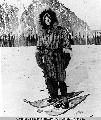On May 26, 1900, Congress gave its approval to build an extensive network of telegraph and cable lines that would link Alaska to the rest of the world. The Washington-Alaska Military Cable and Telegraph System (WAMCATS) would connect Fort Liscum in Valdez to other forts along the Yukon River: Fort Egbert at Eagle City, Fort Gibbon at Tanana, and St. Michael on the Bering Sea coast. A submarine cable would connect Seattle with Valdez.
Captain Charles S. Farnsworth spearheaded the WAMCATS project with Fort Egbert as construction headquarters. It was left to Lt. William Mitchell to complete the 1,497-mile-long line. While wire communication was possible in Fort Egbert by 1900, the route had formerly traveled through Canada. Gen. Adolphus Washington Greeley ordered Mitchell to continue the wire connection from Fort Egbert southward to the other outposts, so that communication would go only through American soil.
In Alaska, much of this soil proved to be soft, muddy swamp that trapped and slowed load-bearing mules. Mitchell investigated possible routes for the wire before making a bold prediction. He decided to commission workers to brave the winters, and work to move supplies on the ice and frozen earth. He moved supplies by dogsled, and prohibited the workers from carrying thermometers that might remind them of the cold.
In June 1903, Lt. William Mitchell completed construction of the first telegraph line to span the interior of Alaska. For the first time, military intelligence officials could transmit telegraphed messages strictly through American soil and international waters.
Mitchell described his revolutionary accomplishment and wilderness expeditions in his book, The Opening of Alaska:
“I have noticed in sub-Arctic and Arctic countries how little most of the residents really know about conditions in the winter time,” Mitchell wrote. “This is because they ‘hole up’ for the entire winter and only go a short distance away from their houses. Although this was one of the coldest parts of the world, it seemed to me the thing to do was to work through the winter getting the material out: the wire, insulators, poles, food supplies, and forage; then to actually construct the lines in the summer, when we could dig holes in the ground and set the telegraph poles.”
Prior to Lt. Mitchell’s innovation, the WAMCATS project had been hampered by harsh winters and unwilling workers. Mitchell didn’t bother employing uninspired laborers. If they grumbled about the elements, he simply hired new people. He efficiently shipped supplies by dogsled during the winter, and completed construction of the telegraph ahead of schedule, connecting the frontier of Alaska to the rest of America. Mitchell’s future as a military pilot and advocate of air power earned him great honor and eventual dishonor. Although he reached the rank of colonel, a controversial court martial tarnished his record until his death in 1936. Still, he received the Medal of Honor posthumously in 1946.
The telegraph line was completed on June 29, 1903. Only a decade earlier, it had taken nearly a year to send a message to the Interior from Washington, D.C., and receive a reply. The wire was an impressive project, but short-lived in usefulness. The Gold Rush died out, and wireless radio connections soon made the use of the telegraph nearly obsolete. In May 1936, WAMCATS became part of the Alaska Communications System (ACS).
|
 |
 |
| William "Billy" Mitchell |
|
|
|
 |
| WAMCATS cable was offloaded at Valdez |
|
|
|
 |
| Military crews and miners were tapped to work the WAMCATS project |
|
|
|
 |
| Wortmann's telegraph station |
|
|
|
 |
| The Beaver Dam Roadhouse |
|
|
|
| Click here for all 9 photos in this gallery. |
|




